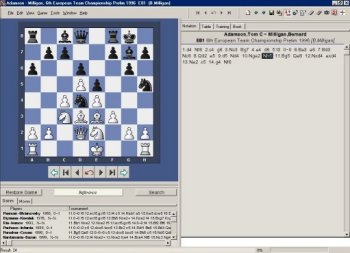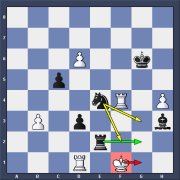 |
ChessBase Reviews |
Last updated 16 July 2001

| index | part 1 | part 2 | part 3 | part 4 | part 5 | part 6 | part 7 | part 8 |
ChessBase 8 Part 6
This time out I thought I would continue with the theme of annotating games. Some of you may have noticed that Liban Van Damme likes to include the game moves from other players in his annotations. This is a very useful tip which you can use when making notes in your correspondence games. As previously mentioned, it is a simple matter to do a search in a database to find games which have reached a particular position. Even if your game doesnít eventually follow the same move order you may still want to reference the game as a particular tactic may still work even if delayed for a few moves. It is therefore useful to have the relevant game references you want stored with your game rather than having to do searches all the time. So how do you get the games you find in your search into the notes of your game?

Itís really quite simple. First of all, when doing a search of any kind remember to search in the correct database if you have more than one. From the main ChessBase 8 window you can do this by right clicking the mouse on the icon of the database you wish to use, select Properties and then tick the box for Reference database.
Back in your game, you can right click the mouse on any of your moves in the box on the right of the screen. You then click on Search Games. If any games are found, a list will appear beneath the game board. Clicking on any games will cause the moves of that game to appear in the box on the right of the screen. You can play through that game as normal. You can switch this to others games found in the search by clicking on that game under the board. If you come across a game you wish to add as notes to you own game then select Edit at the top of the Screen, then Copy, then Copy game.
To return to your own game you simply click on the Restore Game box under the game board. Your game is then once again displayed in the box on the right of the screen. To add the game you have copied select Edit from the top of the screen, then Paste, then Paste Game. The game will be added as a playable variation at the appropriate point in your game. You can ensure this by making sure them move where you want the game placed is highlighted in you game on the right by right clicking that move with your mouse. You can add more than one game by again selecting a found game from search list and following the same procedure as above.
Another useful annotation method is the use of graphic commentary. For example you might add a series of arrows to remind you that you plan to move your knight to square a then b then c over the next few moves. A visual prompt can work wonders the next time you open the game. It wouldnít be the first time that I have come back to one of my games, after receiving a reply several weeks after I sent my move, and wondered why I made my last move. ChessBase uses coloured arrows and squares to allow you to illustrate tactical points and make strategic themes and plans more clear.

In this simple example, White's king has to go to g1. I then play Rg2+ followed either by Ng3# or Nf2# depending on where the king decides to move. I highlighted the starting square for the King red as it was under attack.
The graphic elements are entered using a combination of mouse and keyboard:
| Mark square green, draw green arrow | Press Alt key and click square or draw line from a to b. |
| Mark square red, draw red arrow | Press Alt + Shift and click square or draw line from a to b. |
| Mark square yellow, draw yellow arrow | Press Alt + Ctrl and click square or draw line from a to b. |
If you draw a line with the same colour again you erase it.
Ctrl-Alt-X erases all graphic elements from the current position.
The graphic commentary is stored together with the game and appears automatically during replay.
Having spent the time annotating your game, donít forget to replace it as it would be a pity to lose all your hard work and find the next time you open the game that the commentary isnít there. It would be pretty hard to do as ChessBase prompts you to save the game if you havenít already done so when you try to close the game or the program.